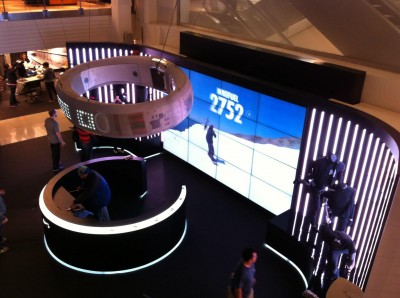Glass options
In video wall applications, the ‘substrate’ is the glass (tempered or plate), polycarbonate resin thermoplastic or acrylic material integrated in front of the screen itself.
Typically, large sheets of tempered glass are optically imperfect, so up-close viewing—i.e. within 0.6 m (2 ft)—can be negatively affected by glass contaminants. They can appear wavy from the tempering process.
Plastic-derivative sheets may be a better option for such deployments, but some of these sheets are too thin. The heat from the video wall’s LCDs can cause them to ‘bow out’ into the IR plane of the touch ‘frame,’ resulting in false touch detections and, thus, a completely useless deployment.
It is important to consider a substrate’s overall durability for shipping, handling and installation in high-traffic areas. Installing large sheets of non-tempered plate glass in tight spaces requires very steady hands to avoid cracking or breaking them. Plastic sheets are much lighter and safer to handle.
The downfall of plastic substrates, however, is their lack of durability against scratches. While a polycarbonate resin thermoplastic is virtually unbreakable due to its flexibility, it can easily be scratched by a user wearing a ring or holding a key. Acrylic is harder and somewhat more resistant, but still easier to scratch than glass.
So, the choice of substrate is a balancing act between these factors. Some companies are comfortable handling glass, which typically is chemically strengthened for interactive displays. And some clients are not too worried about small scratches.

If an existing wall is being used to display a screen array, then it may be necessary to engineer additional structural supports.
Mounting LCD panels
Ultra-narrow-bezel LCDs are becoming popular for video walls because they leave a nearly seamless mullion between screens, but their design is also their Achilles heel, as the internal polarizer micro-wiring and glass are extremely fragile. They are protected by only about 2 mm (0.08 in.) of flexible tin.
As a consequence, an ultra-narrow-bezel LCD cannot bear the weight from another one above it. Any weight applied to the bezel can damage the polarizer, break the internal glass or cause entire columns of the screen to fail.
Similarly, everyday LCD mounts may not be sufficient, considering video walls are very heavy. If the construction is new, the appropriate mounting hardware and weights can be attained and integrated early in the process, with mounting points and surfaces designed accordingly to support the video wall.
If an existing construction is being used, then the structure may have trouble bearing the added weight. Options include support ‘legs’ that can be integrated into the wall-mounting system or using the floor to support the weight vertically. Either way, proper engineering is crucial to ensuring safety.
Serviceability is often overlooked in digital signage deployments. There are mounts specifically designed for video walls that ‘pop out,’ in one fashion or another, for maintenance. These are helpful with multi-row arrays of LCDs, where the central screens can be particularly difficult to access otherwise.
It is also important to consider cable management, ensuring the wiring scheme makes key components accessible for repair. Signal extension cables—e.g. Category 5 (Cat 5) twisted-pair cables, High-Definition Multimedia Interface (HDMI) cables and Universal Serial Bus (USB) extenders—are often the root cause of a video wall failure, so it is important to place them in an accessible location.





